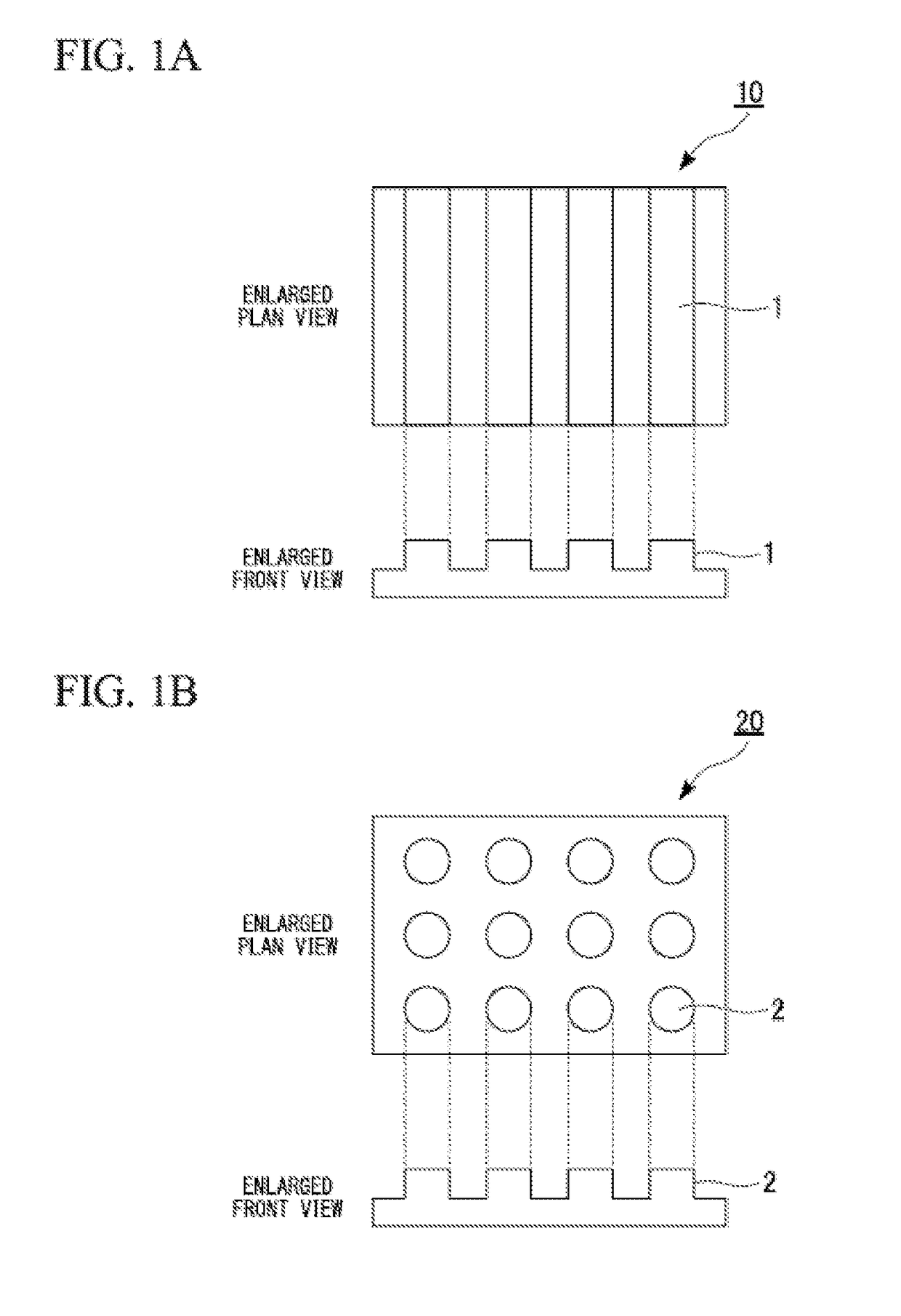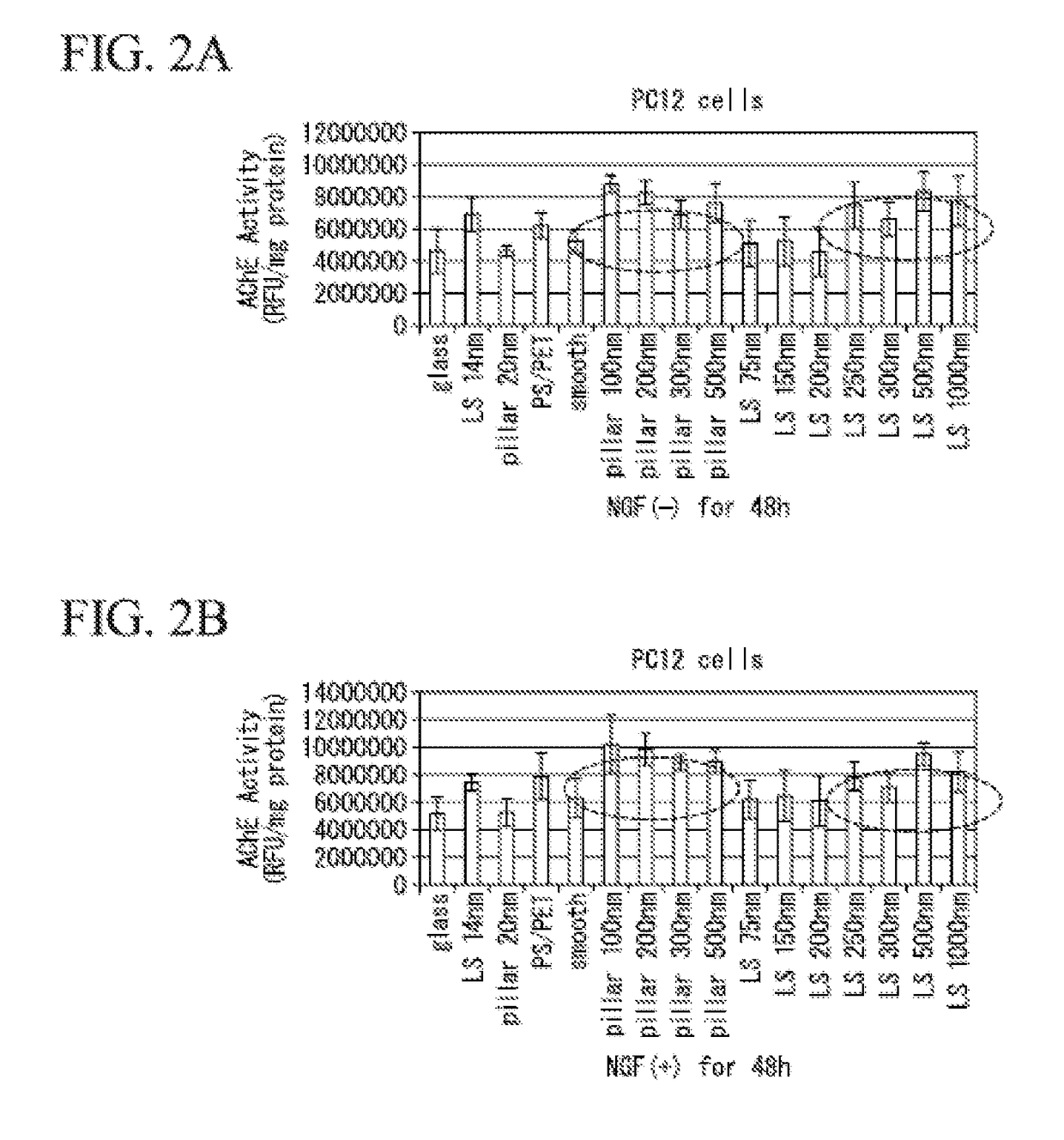Cell culture substrate for trait induction of nerve cell, method of controlling trait of nerve cell, method of extending neurite, method of controlling dopamine secretion, and method of controlling acetylcholinesterase activity
a cell culture substrate and trait technology, applied in the field of cell culture substrate for trait induction of nerve cells, can solve the problems of difficult engrafting, difficult collection of embryonic stem cells or the like, and difficult differentiation of stem cells into nerve cells, etc., to achieve the effect of easy and efficient engraftmen
- Summary
- Abstract
- Description
- Claims
- Application Information
AI Technical Summary
Benefits of technology
Problems solved by technology
Method used
Image
Examples
preparation example 1
Preparation of Substrate by Directed Self-Assembly (DSA)
[0098](1) 0.2 mL of a propylene glycol monomethyl ether acetate solution containing 2 wt % of a block copolymer (number average molecular weight 18,000-b-18,000) of polystyrene and polymethyl methacrylate was dropped on a smooth surface of one sheet of a 0.8 cm×0.8 cm glass base plate (manufactured by Hiraoka Specialty Glass Co., Ltd.) to form a coating film on the base plate. Subsequently, the glass base plate on which the coating film was formed was annealed at 240° C. for 60 seconds. Subsequently, the coated film was subjected to O2 plasma treatment under conditions of a pressure of 40 Pa, a temperature of 40° C., an output of 50 W, a treatment time of 20 seconds, and an oxygen flow rate of 200 ml / min, using a plasma processing apparatus (TCA-3822, manufactured by Tokyo Oka Kogyo Co., Ltd.), and the polymethyl methacrylate portion was selectively dry-etched to obtain a substrate (LS1). In addition, except for using a block c...
preparation example 2
Preparation of Substrate by Transfer from Argon Fluoride (ArF) Pattern
[0101]A radical polymerization negative resist containing a photosensitive resin composition containing an acrylic resin as a main component was used as a photoresist composition. 1 ml of the radical polymerization negative resist was dropped on a 0.8 cm×0.8 cm silicon wafer having a pattern of unevenness (Smooth 3, P2 to P5, and LS2 to LS8) illustrated in Table 1 formed using ArF exposure machine Nikon S308, the coating film was degassed by placing the coating film under a reduced pressure condition of 100 Pa for 30 minutes, and a radical polymerization negative resist was embedded in the uneven pattern. Subsequently, twelve silicon base plates each having the coating film were exposed to an atmosphere with an exposure amount of 999 J / m2 using an ultraviolet irradiation device (HMW-532D, manufactured by ORC Co., Ltd). Subsequently, the film cured by exposure as described above was covered with a base plate prepar...
example 1
Trait Control of Nerve Cell
[0102](1) Culture of the Neural Precursor Cell
[0103]A cell culture test was performed at a culture temperature of 37° C. and 5% CO2 environment using the substrate obtained in Preparation Examples 1 and 2. PC12 cells derived from rat pheochromocytoma (using RIKEN Bank cells, RIKEN Bank RCB 009) were used as the cell to be cultured. As a culture medium, DMEM high glucose medium containing 10% FBS was used. The substrate obtained in Preparation Examples 1 and 2 was placed in a well of a dish with a well, and thereafter 1×104 cells per one substrate were seeded on the surface of the substrate. Thereafter, the culture medium was injected into the well with a disposable pipette and the culture for 1 day was cultured.
[0104]As a result of observing a form of the cells after the culture for 1 day, it was confirmed that the neurites appeared from PC12 cells in a case where substrates of LS3 to LS8 (line and space pattern, width of 150 nm to 1000 nm) and P2 to P5 (p...
PUM
| Property | Measurement | Unit |
|---|---|---|
| width | aaaaa | aaaaa |
| width | aaaaa | aaaaa |
| culturing time | aaaaa | aaaaa |
Abstract
Description
Claims
Application Information
 Login to View More
Login to View More - R&D
- Intellectual Property
- Life Sciences
- Materials
- Tech Scout
- Unparalleled Data Quality
- Higher Quality Content
- 60% Fewer Hallucinations
Browse by: Latest US Patents, China's latest patents, Technical Efficacy Thesaurus, Application Domain, Technology Topic, Popular Technical Reports.
© 2025 PatSnap. All rights reserved.Legal|Privacy policy|Modern Slavery Act Transparency Statement|Sitemap|About US| Contact US: help@patsnap.com



